ADE 2012: Yays, Nays, and Okays
XLR8R has been hitting the festival circuit pretty hard in recent months, and that effort […]
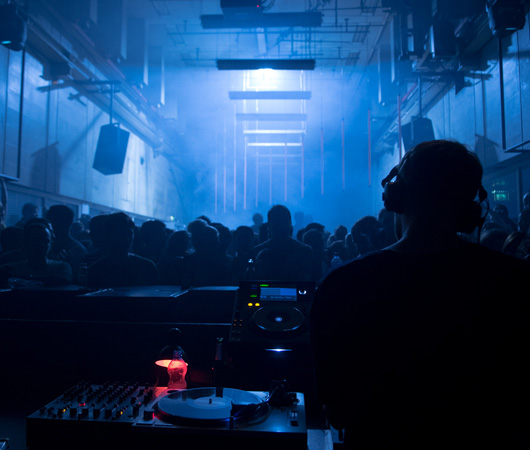
ADE 2012: Yays, Nays, and Okays
XLR8R has been hitting the festival circuit pretty hard in recent months, and that effort […]

XLR8R has been hitting the festival circuit pretty hard in recent months, and that effort continued last week when we hopped a plane for the Netherlands to attend the 2012 edition of the Amsterdam Dance Event. Better known as ADE, the annual event—which first launched back in 1996—is not meant to be a music festival, even though a huge portion of the goings-on revolve around nightly showcases featuring scores of top-flight DJs and performers from around the globe. In actuality, ADE is a five-day electronic-music conference, a place where industry professionals come to network, make deals, evaluate talent and equipment, exchange ideas, and partake in all sorts of things that ultimately have little to do with hearing great music or attending wild events. All that said, ADE did feature some really amazing parties, many of which we’ve detailed in this write-up. Quite frankly, there was a lot to take in at ADE, as the conference schedule included more events and activities than any one person could even hope to attend. Having only made it to a handful ourselves, but still wanting to share the key points of our ADE experience, we’ve organized our thoughts about ADE into three self-explanatory categories: yays, nays, and okays.
Trouw, main room (by Marjolein Scheer)
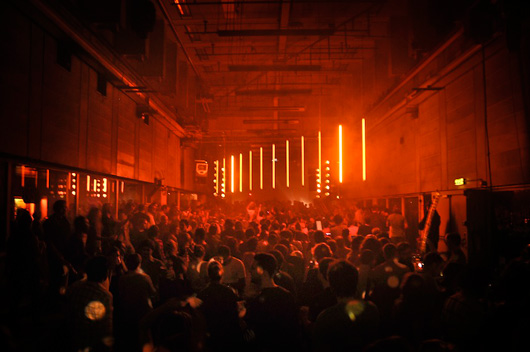
Yay: Trouw
In all honesty, our review of ADE could have been titled, “XLR8R Goes to Trouw.” We found Amsterdam to be full of clubs, most of them equipped with quality soundsystems and having at least a passable vibe, but none of the ones we saw was in the same league as Trouw. Located outside the city center, the club was situated inside a former printing press; as such, it exuded the same sort of post-industrial charm as its like-minded counterparts in Berlin, including the mighty Berghain. In fairness, it may not be quite on that level—then again, what venue is?—but still, there was nothing to find fault with at Trouw. Upstairs is the main room, a long, rectangular behemoth with vaulted ceilings and booming sound. (Interestingly enough, the upstairs is also home to an upscale restaurant.) Downstairs is a smaller—although by no means small—room, and while its sound was slightly inferior to its upstairs counterpart, the space also had a sort of gritty basement vibe that was rather enjoyable. On the whole, Trouw appeared to offer everything a club should—it was dark, sweaty, and refreshingly free of bullshit. Night after night at ADE, some of the most interesting bills were happening at Trouw; the club’s staff clearly took—and continues to take—the curation of its line-ups seriously. It gave the impression of being a place where music comes first, which is why we kept coming back to Trouw again and again throughout the week. (Literally, we went there four nights in a row.)
DJ Harvey and Andrew Weatherall (by Marjolein Scheer)
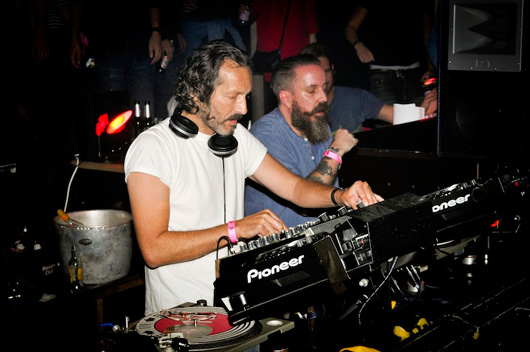
Yay: DJ Harvey and Andrew Weatherall
Saturday night’s party at Trouw was actually something we originally planned to skip. After all, we had already been at the venue on Thursday and Friday, so a third night in a row seemed a bit excessive. Yet it ultimately proved impossible to ignore the lure of two DJ legends, DJ Harvey and Andrew Weatherall, doing an all-night, back-to-back set. The party was sponsored by Resident Advisor, and when we strolled in around 3 a.m., the dancefloor was absolutely rammed. More importantly, spirits were high, as the veteran pair served up a wonderful mix of disco and house that was alternately funky, Balearic, and euphoric. Dancers surrounded the DJ booth on all sides, most of them with giant smiles on their face, and when the lights came on at 5 a.m., it felt like things were ending far too early. Harvey and Weatherall likely could have keep that crowd moving well into the next day.
Maya Jane Coles (by Laura Andalou)
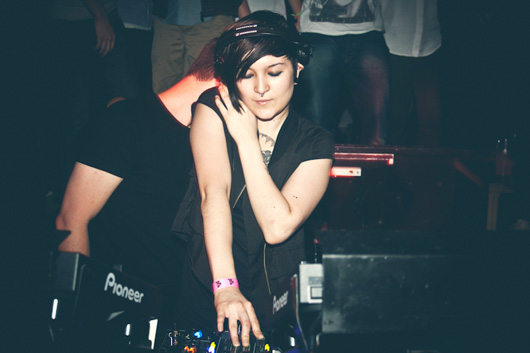
Nay: Industry dudes
Despite all the great talent at ADE, it’s important to remember that it’s not a festival. It’s actually an industry conference, something akin to US events like Miami’s Winter Music Conference, Austin’s South by Southwest, or New York’s CMJ Music Marathon. Because of that, though the nights may be filled with parties, the days are full of meetings, panel discussions, and workshops. Granted, these sorts of things happen at almost every large-scale event these days, but the “industry” feel of ADE is particularly hard to ignore. All week long, networking was happening en masse, as managers, booking agents, talent buyers, promoters, label owners, distributors, gear manufacturers, internet entrepreneurs, online retailers, journalists, and innumerable other music-industry middlemen descended upon the city. And while all these folks would undoubtedly pay lip service to the importance of “the music” if asked, it didn’t take a discerning eye to see that many of these dudes—and make no mistake, this group of attendees was overwhelmingly male—was more concerned with making money than facilitating great music or interesting art.
Obviously, XLR8R isn’t staffed by anarchists or socialists. We too are a business, sell ads on the site, and yes, make money. Nevertheless, there was something unseemly about seeing these men—many of whom undoubtedly got into the industry with good intentions—talking shop, trading figures, and essentially doing whatever they could to further commodify electronic music. For all the talk of EDM in the past year or so, there has been little examination of what’s driving it and who is making the decisions that are pushing certain (often questionable) artists and various (usually awful) strains of electronic music toward the mainstream. Well, we can say without question that a sizable portion of those responsible were in attendance at ADE. They were businessmen in music enthusiasts’ clothing, guys with mortgages to pay and bottom lines to worry about. We’re not saying they’re bad people—attending ADE isn’t akin to hanging out with investment bankers and oil men—but their ultimate motives had little to do with our own, which is why we generally stayed as far away as possible. Thankfully, ADE’s wealth of events and musical variety made that an easy task.
Tom Trago (by Lotte Koster)
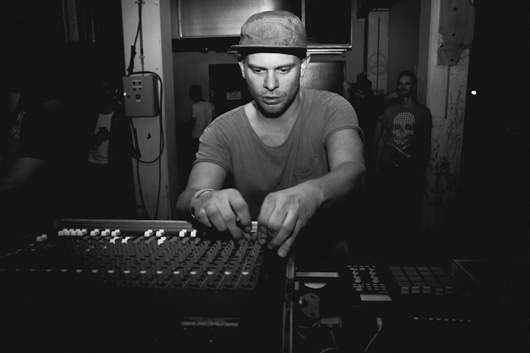
Yay: Rush Hour, Clone, and Delsin
XLR8R has an unabashed affinity for Rush Hour, so it was nice to observe the famed record label and store operating on its own turf at ADE. Throughout the week, the intimate shop played host to in-store DJ sets from the likes of Ben UFO, Pearson Sound, Tom Trago, Pangaea, Dexter, Sadar Bahar, and several others. Apart from that, the Rush Hour crew also linked up with fellow Dutch imprints Clone and Delsin to put on some events. While the label trio’s installment of the Boiler Room on Friday afternoon was a bit of a letdown—largely because of the venue, which suffered from an overworked and underpowered soundsystem—the crews lived up to their reputations later that evening at Trouw, where they packed the house with essentially an all-Dutch line-up that included the likes of Conforce, A Made Up Sound, Dexter, Gerd, Tom Trago, Legowelt, and others. The place was packed, classic-sounding house, techno, and electro filled the air, and the artists performing all brought their “A” game.
Peter Van Hoesen at the Boiler Room
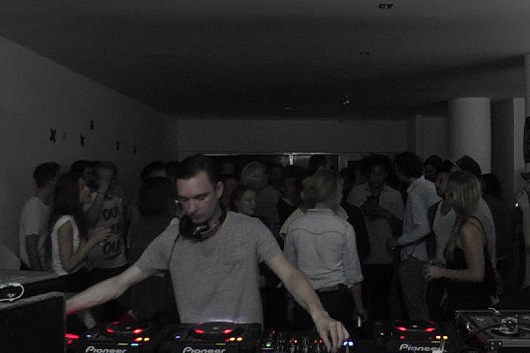
Okay: Boiler Room
The Boiler Room held three separate sessions during ADE, and while the troubles of the final installment brought down its average for the week, it’s rather hard to criticize the BR crew too harshly. When hosting its regular editions in London, Berlin, and LA, the Boiler Room has a lot more control over its environment. And though it’s encouraging to see the Boiler Room team hitting the road, the on-location episodes are ultimately a bit of a wild card. That said, it usually still works out. Wednesday’s episode took place in a gallery space just south of central Amsterdam, offering a cheerful afternoon soundtracked by increasingly energetic sets from Nina Kraviz, Dexter, Agoria, Peter Van Hoesen, and Cajmere. Van Hoesen was particularly good, weaving together a pumping techno set colored by plenty of melody and a few rave-minded selections, including Kink’s “Existence,” which prompted an explosion of enthusiasm from the crowd. Apparently, Thursday evening’s Boiler Room—hosted by the Innervisions label and featuring DJ sets from Dixon and Ame—was similarly lively, but we were unable to attend.
Simian Mobile Disco
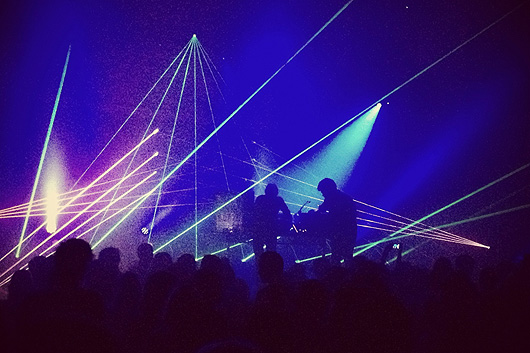
Yay: Simian Mobile Disco
A year ago, the thought of attending, let alone praising, a Simian Mobile Disco show would have seemed laughable to XLR8R. That’s not meant as a slight to the UK duo, it’s just that we had sort of written them off as a more pop-inclined electronic act, one that had given up “serious” music in favor of a more commercial approach. Then came Unpatterns, the pair’s stellar LP from earlier this year and an effort which reestablished its producers as purveyors of quality techno. Curious how that spirit would translate to the Simian Mobile Disco live show, we caught the pair at an oddly early show on Thursday night at Paradiso. The set began at 9 p.m., but the mid-sized venue was already stuffed and thankfully, Simian Mobile Disco delivered the goods. Performing live with a fleet of gear, including a giant modular synth, the two men constructed one distinctively melodic techno track after another, occasionally dusting tunes with a little extra pop flair and mixing in some re-worked versions of a few older SMD cuts along the way. Flanked by clouds of fog and a stripped-down array of lazers, Simian Mobile Disco’s live show was, quite simply, great. While fans simply waiting to hear “Hustler” or the pair’s remix of “We Are Your Friends” might have left disappointed, those in search of something deeper—but still undeniably light and fun—went home happy.
Yay: Audio Culture
ADE 2012 had more than its share of praiseworthy figures, but Amsterdam’s Audio Culture crew might have taken home the week’s proverbial MVP award. Known for their support of emerging sounds and up-and-coming producers, the guys behind this club-night-turned-label were seemingly everywhere, assisting in the production of the Boiler Room throughout the week and capping things off with a showcase of their own on Saturday night. Taking place at Club Up, the smallish venue was stuffed to capacity early, as an impressive line-up that included South London Ordnance, Hackman, Presk, Tessela, GoldFFinch, and others served up a tasty combination of house, techno, garage, and bass music. The crowd was young (but not too young), the vibes were good, and the assortment of new talent on display was impressive. If labels like Rush Hour, Clone, and Delsin are The Netherlands’ old guard, the members of Audio Culture appear to have their finger on the pulse and are more than capably filling their roles as Amsterdam’s young guns. We’ll be intently watching the label and party continue to develop in the months and years ahead.
Carl Craig (by Shawn Reynaldo)
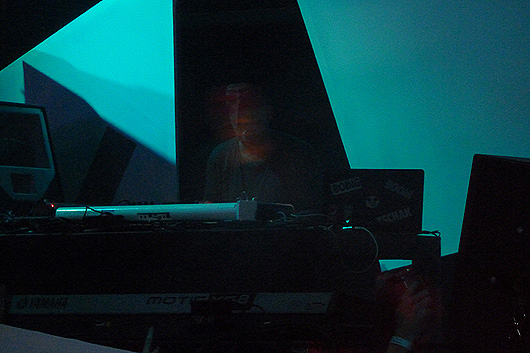
Yay: Carl Craig
Detroit veteran Carl Craig has been touring his 69 live show all summer, and we finally got the chance to check it for ourselves at Wednesday night’s Dekmantel/Paramount Artists showcase. The bill at the spacious MC Theater was stacked, as the evening also featured sets from Nina Kraviz, Trus’me, Stacey Pullen, and Paul Woolford, but Craig was the biggest “name” on the line-up. Thankfully, his set lived up to expectations, as Craig—who was sporting a provocative, Eyes Wide Shut-esque mask—unfurled an hour of epic, melody-driven techno. Deep without being monotonous, he would periodically drop the beat altogether, indulging in lush, analog-sounding synth tones before bringing back the techno pulse and riling up the dancefloor all over again. At this point in his career, Craig knows what he’s doing and, more importantly, knows how to work a room. That’s exactly what he did at ADE.
Nina Kraviz (by Johan Vivié)
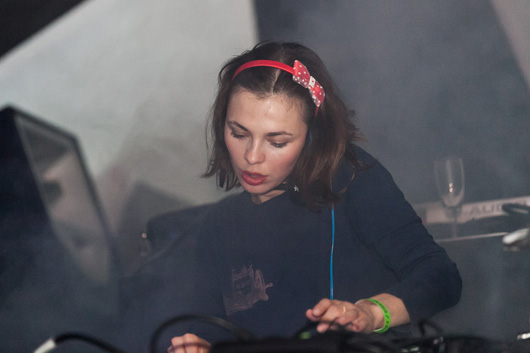
Okay: Nina Kraviz
People love to argue about Nina Kraviz, and that trend won’t be alleviated by her stops at ADE. On Wednesday, she warmed up the Boiler Room, although her early time slot (around 3 p.m.) and the room’s relatively mellow energy at that hour made judging her performance a tough task. That evening, she spun right before Carl Craig at the aforementioned Dekmantel/Paramount Artists party, and kept the room going with a set that largely consisted of hard, Berlin-style techno. It wasn’t bad, but it did feel a bit flat and definitely made us long for something deeper. Maybe its our imagination, but Kraviz appears to be moving away from the Underground Quality-style deep house that she originally made her name with, and we’re not entirely convinced that the change suits her. On the other hand, her ADE set was only 90 minutes, so perhaps she would have done a little more sonic exploring if she had had a longer timeframe at her disposal. Simply put, we’ve seen her play better, but we’re willing to give her the benefit of the doubt for now.
Legowelt & Xosar (by Lotte Koster)
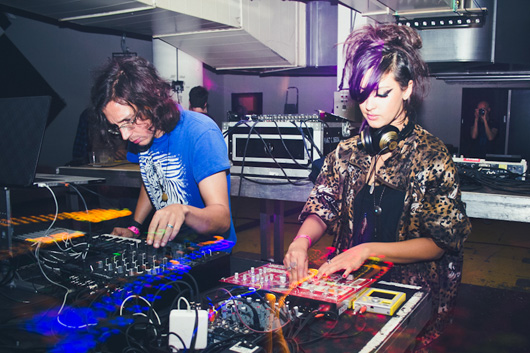
Yay: Legowelt and Xosar
Over the past year, Dutch eccentric Legowelt has increasingly appeared with the shadowy Xosar at his side, the pair often touring together or collaborating under a number of different monikers. The two teamed up once again on Friday night at Trouw, performing live in the second room with an impressive assortment of gear. Even more impressive is that the duo managed to stand out on a line-up that was—as described earlier—overflowing with talent. Nevertheless, there was something particularly compelling about Legowelt’s and Xosar’s music, a melange of classic house and techno tropes with a clear preference for vintage drum sounds, simple—yet potent—rhythms, and thick washes of fuzzy synth melodies. Crafting sounds that were both propulsive and hypnotic, the duo built a tangible vibe over the course of an hour, an especially difficult task given that most, if not all, of the material was unknown to the audience.
Serge and Gerd (by Lotte Koster)
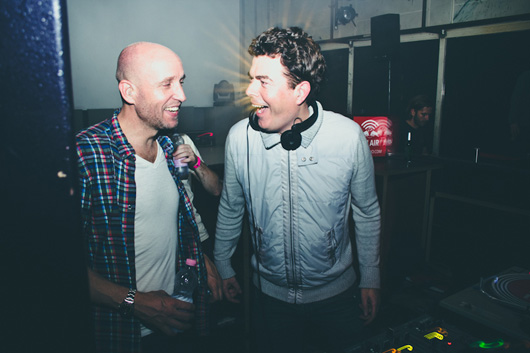
Yay: Gerd
Another standout from the Rush Hour/Clone/Delsin party at Trouw was Gerd, who spun in the main room shortly after midnight. The man has been turning out classic-sounding cuts since the mid ’90s, but he’s been on a major roll as of late, dropping a number of high-profile remixes and finding himself increasingly namechecked by DJs from various corners of the dance-music spectrum. On this night, he clearly brought his wealth of experience to the table, putting together a set of stripped-down, no-frills house that consistently referenced the past without sounding cliché. Gerd is not a retro artist—he simply understands what was great about old-school New York and Chicago house and employs those elements in his own work. His DJ set at ADE may not have had lot of bells and whistles, or even a wealth of big tunes, but everything he played worked, and the crowd was more than pleased with the results.
Ben UFO and Pearson Sound (by Shawn Reynaldo)
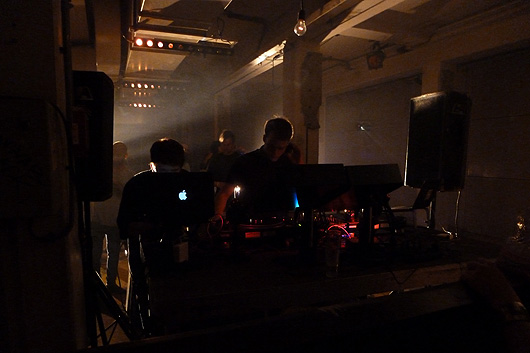
Yay: Hessle Audio
One night earlier at Trouw, the three founders of Hessle Audio—Ben UFO, Pearson Sound, and Pangaea—came together for a special back-to-back session. Holding down the club’s second room for the entire night (while Maya Jane Coles and Jackmaster piloted the main room), the boys began slowly, clearly reveling in the chance to exhibit their musicological inclinations to the fullest. With seven hours at their disposal, the DJs moved through various bits of dubstep, garage, house, techno, and more, seemingly taking a particular delight in exploring the spaces between genres. And while all three have their specialties, they functioned incredibly well as a unit, working together toward building a larger whole. Not all DJs are equipped to handle this sort of assignment, but the Hessle Audio crew was at its best when given so much freedom to operate.
MC Theater (by Shawn Reynaldo)
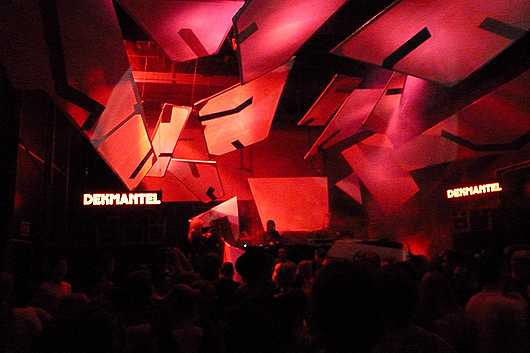
Okay: Amsterdam
Amsterdam is cute—really cute. Between the canals and the fairy-tale architecture, it was hard to be bummed out by our surroundings in the Dutch capital. At the same time, it occasionally felt a little sleepy, even when the city was in the midst of a large-scale conference/festival like ADE. On the one hand, that was great, as attending ADE rarely felt like an unmanageable or overwhelming experience. Nevertheless, Amsterdam did lack some of the excitement and energy that the hustle-and-bustle of a larger city—or even a more concentrated one—might have brought to the table. The concentration issue was particularly important; although many clubs and the conference headquarters were clustered near the city center, many others were not, meaning that attending events often required either long walks or short cab rides. (There’s a reason that seemingly everyone in Amsterdam was scooting around on a bicycle. Having one would have helped immensely during ADE.) Nevertheless, getting around the city was never truly difficult; the city’s public transportation system was relatively easy to navigate and taxis, although moderately expensive, were plentiful, especially around clubs late at night.
Pleasant is a great word to describe Amsterdam—even with its chilly, intermittently rainy weather—and that sensation went a long way toward making ADE an enjoyable experience. People were friendly, and everyone spoke English (without giving anyone an attitude about it), which certainly made things easier for all the Americans, Brits, Germans, and other non-Dutch-speaking attendees. It’s also worth noting again that despite its relatively small size, Amsterdam has a wealth of clubs, making it well equipped to handle the week’s festivities. Even better, almost every club we visited had a soundsystem that would at least qualify as good, if not great. Unlike some other places (including most cities in the US), club owners in Amsterdam appeared to understand the importance of sound quality in the context of dance music. It really made everything better; even when the music went south, it at least wasn’t grating on our ears, and when the music was good, the ace systems made it sound great.
Trouw, downstairs (by Laura Andalou)
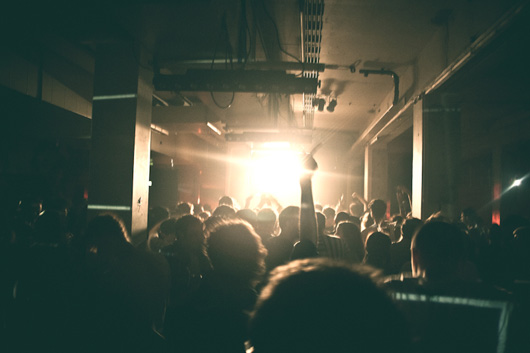
Despite all its positives, we can say that Amsterdam was lacking in one key area—food. Based on our (admittedly limited) observations, the city’s food culture had a ways to go. On-the-go options were virtually nonexistent, apart from a smattering of stands selling Belgian fries and/or waffles. Like any major European city, Amsterdam also had its share of mediocre doner kebab and pizza shops, but even those were lacking in number. More disappointingly, all these establishments seemed to close somewhat early, even in the most tourist-oriented and club-filled areas of the city. Not having food options for legions of intoxicated youngsters when they wander out of the club at four or five a.m. seemed like an odd choice to us, but that was what we found. On the other hand, maybe not eating a bunch of garbage food in the wee hours before going to bed is why the Dutch are, on the whole, a rather thin people. It certainly isn’t hurting them in that department. Speaking of the Dutch…
Nay: Dutch people are tall
There’s not really a lot more to say about this topic, and maybe it’s not fair to list this as a “nay,” but damn, we have never felt so short in our lives. Maybe it’s genetic, maybe it’s the food, but people are fucking tall in Amsterdam.
Jackmaster (by Laura Andalou)
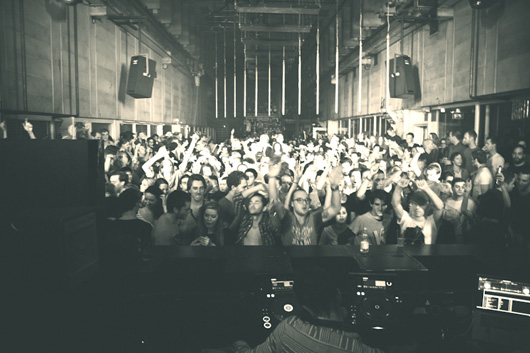
Yay: Organization and Curation
Without question, ADE is a large event, one with a scale that exceeds most festivals and many music conferences. While outsiders often lump the various facets of electronic and dance music into a single nebulous category, it was clear throughout the week that ADE organizers recognized the complexity of this musical sphere, and did their best to cater to a wide swath of potentially interested participants. Day after day, the wealth of ADE-related options was simply dizzying. The sheer volume of panel discussions, workshops, roundtables, demonstrations, and, of course, parties was impressive. And while this made seeing even a fraction of everything and everyone we wanted to see impossible, it also enabled attendees to make their own experience. We might have grumbled about all the industry dudes who came to ADE, but we’re fairly certain that they enjoyed the chance to come to Amsterdam and “do business.” Each night, there were literally dozens of parties one could attend; even when 75% of the bills featured DJs we wouldn’t be caught dead listening to (yes, the ADE line-up included plenty of trance and tacky house), there were always multiple things we most definitely did want to check out, often times at venues that were on par with some of the best clubs in the world.
More importantly, even with all this activity, ADE ran like clockwork. It undoubtedly helps that the festival/conference is put on by a non-profit organization that gets plenty of government funding, but ADE took those resources, made an extensive plan, and followed it. Throughout the week, there was never a sensation that corners were being cut, problems were mounting, or important details were not being attended to. Shows ran on time. Schedules were followed. The ADE website and mobile app were relatively easy to navigate and, more importantly, easy to understand. Parties weren’t beset by technical issues. Local promoters were invited to participate and were given the freedom to do what they do, with minimal interference from the festival apparatus. Wherever we went, locals seemed happy about ADE, which is always a good sign.
Obviously, no one was going to like everything about ADE, but the conference/festival didn’t require or even expect that from its attendees. The event’s strength stemmed from its wealth of possibilities, which is likely why the 2012 edition was said to be the biggest ADE yet. In short, there was something at ADE for everyone, and it’s hard to find much fault in that.

